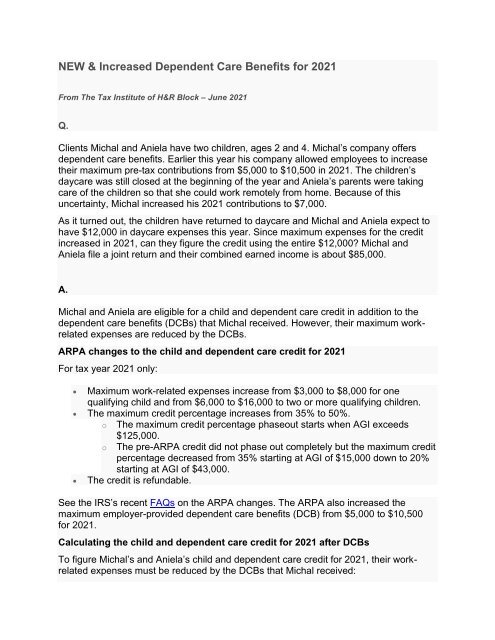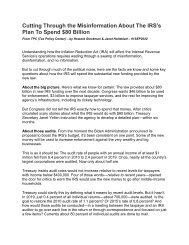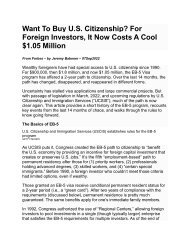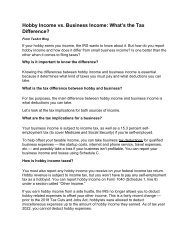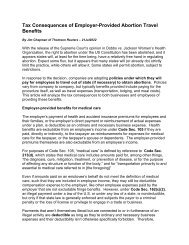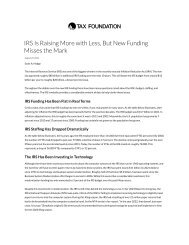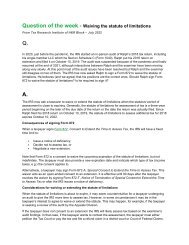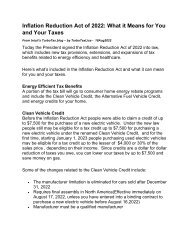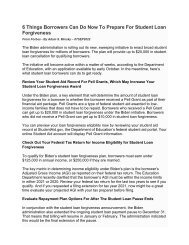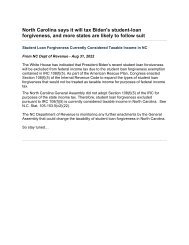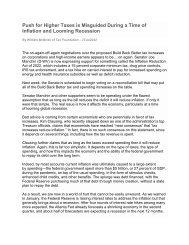NEW Dependent Care Benefits for 2021
Create successful ePaper yourself
Turn your PDF publications into a flip-book with our unique Google optimized e-Paper software.
<strong>NEW</strong> & Increased <strong>Dependent</strong> <strong>Care</strong> <strong>Benefits</strong> <strong>for</strong> <strong>2021</strong><br />
From The Tax Institute of H&R Block – June <strong>2021</strong><br />
Q.<br />
Clients Michal and Aniela have two children, ages 2 and 4. Michal’s company offers<br />
dependent care benefits. Earlier this year his company allowed employees to increase<br />
their maximum pre-tax contributions from $5,000 to $10,500 in <strong>2021</strong>. The children’s<br />
daycare was still closed at the beginning of the year and Aniela’s parents were taking<br />
care of the children so that she could work remotely from home. Because of this<br />
uncertainty, Michal increased his <strong>2021</strong> contributions to $7,000.<br />
As it turned out, the children have returned to daycare and Michal and Aniela expect to<br />
have $12,000 in daycare expenses this year. Since maximum expenses <strong>for</strong> the credit<br />
increased in <strong>2021</strong>, can they figure the credit using the entire $12,000? Michal and<br />
Aniela file a joint return and their combined earned income is about $85,000.<br />
A.<br />
Michal and Aniela are eligible <strong>for</strong> a child and dependent care credit in addition to the<br />
dependent care benefits (DCBs) that Michal received. However, their maximum workrelated<br />
expenses are reduced by the DCBs.<br />
ARPA changes to the child and dependent care credit <strong>for</strong> <strong>2021</strong><br />
For tax year <strong>2021</strong> only:<br />
• Maximum work-related expenses increase from $3,000 to $8,000 <strong>for</strong> one<br />
qualifying child and from $6,000 to $16,000 to two or more qualifying children.<br />
• The maximum credit percentage increases from 35% to 50%.<br />
o The maximum credit percentage phaseout starts when AGI exceeds<br />
$125,000.<br />
o The pre-ARPA credit did not phase out completely but the maximum credit<br />
percentage decreased from 35% starting at AGI of $15,000 down to 20%<br />
starting at AGI of $43,000.<br />
• The credit is refundable.<br />
See the IRS’s recent FAQs on the ARPA changes. The ARPA also increased the<br />
maximum employer-provided dependent care benefits (DCB) from $5,000 to $10,500<br />
<strong>for</strong> <strong>2021</strong>.<br />
Calculating the child and dependent care credit <strong>for</strong> <strong>2021</strong> after DCBs<br />
To figure Michal’s and Aniela’s child and dependent care credit <strong>for</strong> <strong>2021</strong>, their workrelated<br />
expenses must be reduced by the DCBs that Michal received:
$12,000 work-related expenses<br />
-$ 7,000 DCBs<br />
$ 5,000 maximum work-related expenses <strong>for</strong> the child and dependent care credit.<br />
Since Michal’s and Aniela’s AGI is less than $125,000, their credit percentage is the<br />
maximum 50%.<br />
$5,000 × 50% = $2,500<br />
If Michal did not receive DCBs, they could have used the full $12,000 work-related<br />
expenses to calculate the credit and their credit would have been $6,000. Or, if Michal<br />
had opted <strong>for</strong> the maximum pre-tax contribution of $10,500, their credit would be<br />
calculated based only on the remaining $1,500 of eligible expenses and their credit<br />
would have been $750. Although the <strong>2021</strong> credit is more generous, the <strong>for</strong>mula <strong>for</strong><br />
calculating the child and dependent care credit when a taxpayer also receives DCBs<br />
has not changed.<br />
The expanded child and dependent care credit and DCB rules expire after <strong>2021</strong> unless<br />
extended.


